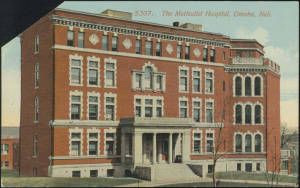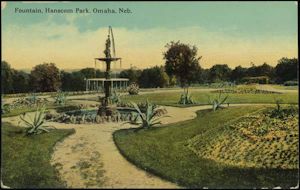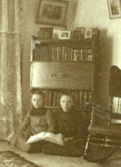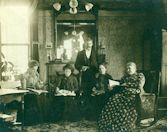Search the Blog
Categories
- Books & Reading
- Broadband Buzz
- Census
- Education & Training
- General
- Grants
- Information Resources
- Library Management
- Nebraska Center for the Book
- Nebraska Memories
- Now hiring @ your library
- Preservation
- Pretty Sweet Tech
- Programming
- Public Library Boards of Trustees
- Public Relations
- Talking Book & Braille Service (TBBS)
- Technology
- Uncategorized
- What's Up Doc / Govdocs
- Youth Services
Archives
Subscribe
Category Archives: Information Resources
Survey of Current Business to be published online only
The monthly Survey of Current Business is Bureau of Economic Analysis (BEA)’s definitive source of information about its economic accounts. Articles in the Survey present the latest national, international, regional, and industry estimates; describe the methodologies used to prepare the estimates; provide information about major revisions; discuss on-going innovations; and generally keep users up to date on relevant BEA issues and initiatives. Each issue includes numerous tables and charts of various economic estimates. Each issue also includes a message from BEA’s director.
Beginning with the February 2014 issue, the Bureau of Economic Analysis (BEA) will discontinue publishing paper copies of the Survey of Current Business. BEA will continue to publish the Survey as a free online publication on its Web site (www.bea.gov). In recent years, usage of the print publication has declined, and budgetary pressures have increased, resulting in the decision to maintain the online publication only.
Sign up for email notifications when each issue of the Survey is available is on www.bea.gov.
Paper copies of SCB issues through February 2014 will continue to be available from the Government Documents collection at the Nebraska Library Commission.
Immigration and Citizenship Information and Resources
The U.S. Citizenship and Immigration Services (USCIS) and Institute of Museum and Library Services (IMLS) have recently entered into a partnership to provide immigration and citizenship information and resources to public libraries across the country. This agreement is founded upon the recognition that libraries serve as a vital resource for immigrant communities. Through the partnership, USCIS and IMLS seek to ensure that libraries have the necessary tools to refer their patrons to accurate and reliable sources of information on immigration-related topics.
For a general overview of the agreement and how libraries can get involved, I encourage you to visit the USCIS Citizenship Resource Center where you’ll find a section of the site dedicated to libraries (http://www.uscis.gov/citizenship/organizations/libraries). On this page, librarians can find information on upcoming USCIS webinars, download educational resources, register for email alerts, and identify contact information for local USCIS Community Relations Officers who can help facilitate opportunities for further engagement.
Britannica Database Trials
Britannica Digital Learning is inviting Nebraska libraries to trial eleven of their online databases during the month of March. The services available to trial include:
- Britannica Online Academic Edition
- Britannica Online Public Library Edition
- Britannica Online School Edition
- Merriam Webster Unabridged
- Annals of American History
- Spanish Reference Center
- World Data Analyst Online
- Britannica ImageQuest
- Global Reference Center
- Britannica Pathways: Science
- SmartMath Practice
Trial access instructions were distributed via a March 6, 2014 message to the TRIAL mailing list. If you did not receive this information and would like to have it sent to you, please email Susan Knisely
Discounted pricing and ordering instructions for these databases are available online.
Want to receive email notification of future database trials and discount pricing? Make sure you are signed up for the Nebraska Library Commission’s TRIAL mailing list. You can learn more about mailing lists maintained by the Nebraska Library Commission, including how to subscribe, on our Nebraska Library Commission’s Mailing Lists page.
Posted in Information Resources, Technology
Leave a comment
The Digital Comic Museum
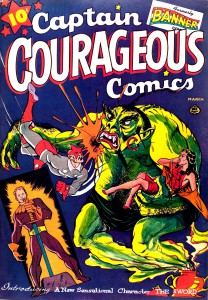 Like old comics? How about free digital versions of old comics? Check out the Digital Comics Museum!
Like old comics? How about free digital versions of old comics? Check out the Digital Comics Museum!
Welcome to DCM! Our mission with this site is providing as close to a free resource as possible where users can easily download public domain golden age comics without the need to ask or worry about searching the net for them.
For now there will be no download limit on registered users but this might have to change. Depending on donations and bandwidth usage we might have to return to download limits on non VIP members. Donators to DCM and Scanners who upload will never have limits placed on them.
If you wish to help out with DCM then please contact us or use the Donate link on the site. We are looking for uploaders, researchers, donators and moderators. If you contact us we will be able to provide details about each job position.
Thanks, digitalcomicmuseum.com
Posted in Information Resources
Leave a comment
Nebraska Librarians Encouraged to help Library Customers Access Financial Aid Toolkit
The U.S. Department of Education’s Office of Federal Student Aid recently launched a new website called the Financial Aid Toolkit :A One-Stop Shop for Financial Aid Resources
Who is the Financial Aid Toolkit for?
The toolkit is for
- librarians;
- staff or volunteers at community based organizations;
- guidance counselors;
- college access advisers; and
- anyone who assists students through the process of learning about, receiving, and repaying financial aid for their higher education.
What information is in the Financial Aid Toolkit?
The toolkit consolidates financial aid resources into a searchable online library, making it easy for users to quickly access the information they need to support their students. The searchable library provides resources covering the entire financial aid lifecycle from applying for financial aid to repaying loans and includes items such as
- “financial aid night” materials and presentations,
- brochures,
- videos, and
- sample tweets and Facebook posts.
The toolkit also offers professional development information such as training opportunities and resources for self-instruction.
Where can a student find other financial aid resources?
Students should visit StudentAid.gov for financial aid information and can find a library of resources designed for them at StudentAid.gov/resources.
How can library or museum professionals spread the word to colleagues about the toolkit?
You can share information about the site by distributing the Financial Aid Toolkit fact sheet.
– See more at: http://blog.imls.gov/?p=4536#sthash.MTZZ02MR.dpuf
Please comment below to share information about whether you are seeing more students and their families seeking financial aid information in your library.
From: James Lonergan, Senior Library Program Officer, IMLS
ALA launches free e-government webinar series
 The American Library Association (ALA) and the Information Policy & Access Center (iPAC) at the University of Maryland at College Park are pleased to announce the re-launch of Lib2Gov, an online e-government resource for librarians. Over the past few months, both organizations have worked to transition LibEGov—a project supported by the Institute of Museum and Library Services through a National Leadership Grant—into Lib2Gov.
The American Library Association (ALA) and the Information Policy & Access Center (iPAC) at the University of Maryland at College Park are pleased to announce the re-launch of Lib2Gov, an online e-government resource for librarians. Over the past few months, both organizations have worked to transition LibEGov—a project supported by the Institute of Museum and Library Services through a National Leadership Grant—into Lib2Gov.
The redesigned website Lib2Gov allows libraries and government agencies to come together and collaborate, share resources and build a community of practice. Lib2Gov now provides a dedicated space where librarians can share materials, lesson plans, tutorials, stories, and other e-government content. The website offers a variety of resources from government agencies and organizations, including information on immigration, taxation, social security and healthcare.
In a few weeks, both organizations will host a new monthly webinar series, “E-government @ Your Library.” The webinars will explore a variety of e-government topics that will be of interest to librarians, including mobile government and emergency preparedness, response and recovery. All webinars are free and will be archived on the Lib2Gov site. The webinar schedule for Winter/Spring 2014:
Webinar 1: E-government @ Your Library (Wednesday, February 26, 2014, at 2 p.m. EST)
This webinar offers general insights into how libraries can help meet the e-government needs of their communities in general and through the Lib2Gov web resource. Register now.
Speakers:
- John Bertot, Ph.D., co-director, Information Policy & Access Center (iPAC), and professor, in University of Maryland College Park’s iSchool
- Ursula Gorham, graduate research associate, iPAC and doctoral candidate, University of Maryland College Park iSchool
- Jessica McGilvray, assistant director, Office of Government Relations at the American Library Association’s Washington, D.C. office
Webinar 2: Government Information Expertise Online: Beyond the First Century of Federal Depository Library Program Practice (Thursday, March 27, 2014, at 3 p.m. EST)
This webinar will offer insights and techniques in how practicing government information professionals can use the strengths and opportunities of the depository library experience in several promising areas of digital reference, government information discovery tools and deliberative outreach to your community. Register now.
Speakers:
- Cynthia Etkin, senior program planning specialist, Office of the Superintendent of Documents, U.S. Government Printing Office (GPO)
- John A. Shuler, associate professor, University of Illinois, Chicago University Library
Webinar 3: An Introduction to Mobile Government Apps for Librarians (Wednesday, April 30, 2014, at 2 p.m. EST)
The webinar will cover how librarians can teach patrons to use mobile devices, provide links on our webpages to government apps, and create apps for their own e-government websites. Register now.
Speakers:
- Isabelle Fetherston, teen librarian, Pasco County Library System
- Nancy Fredericks, member, Pasco County Library System Library Leadership Team
Webinar 4: Roles for Libraries and Librarians in Disasters (Thursday, May 15, 2014, at 2 p.m. EST)
This webinar presents information on libraries’ and librarians’ roles supporting their communities and the disaster workforce before, during, and after hazardous events and disasters. Register now.
Speakers:
- Siobhan Champ-Blackwell, librarian, U.S. National Library of Medicine Disaster Information Management Research Center
- Cindy Love, librarian, U.S. National Library of Medicine Disaster Information Management Research Center
- Elizabeth Norton, librarian, U.S. National Library of Medicine Disaster Information Management Research Center
Webinar 5: Beta.Congress.Gov (Thursday, June 12, 2014, at 2 p.m. EST)
Sign-up information, as well as more information about webinar topics and speakers, is available. Please contact Jessica McGilvray (jmcgilvray@alawash.org) or John Bertot (jbertot@umd.edu) with questions about Lib2Gov or the webinar series.
Let’s Go to the Theater!
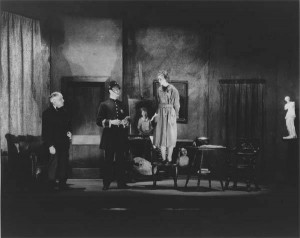 When it’s cold and snowy outside, there’s nothing quite like watching a play in a warm and cozy theater. This was as true in days gone by as it is today, as evidenced by the many theater pictures in Nebraska Memories. For example, the Omaha Community Playhouse presented plays ranging from “A Kiss for Cinderella” (with Henry Fonda and Dorothy McQuire), to “A Christmas Carol.”
When it’s cold and snowy outside, there’s nothing quite like watching a play in a warm and cozy theater. This was as true in days gone by as it is today, as evidenced by the many theater pictures in Nebraska Memories. For example, the Omaha Community Playhouse presented plays ranging from “A Kiss for Cinderella” (with Henry Fonda and Dorothy McQuire), to “A Christmas Carol.”
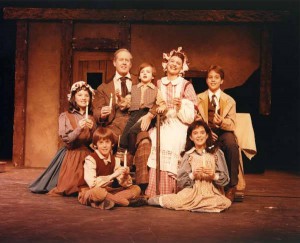 The Lincoln Community Playhouse gave performances of “The Silver Whistle,” “The Solid Gold Cadillac,” and “The Crucible,” a play by Arthur Miller.
The Lincoln Community Playhouse gave performances of “The Silver Whistle,” “The Solid Gold Cadillac,” and “The Crucible,” a play by Arthur Miller.
Even the theater at Camp Atlanta, a prisoner of war camp near Holdrege, Nebraska, put on plays for U.S. military personnel and prisoners of war. The picture below is of a theatrical production of “Lovers.” 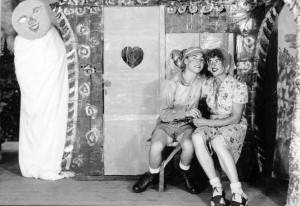
Visit Nebraska Memories to search for or browse through many more historical images digitized from photographs, negatives, postcards, maps, lantern slides, books and other materials.
Nebraska Memories is a cooperative project to digitize Nebraska-related historical and cultural heritage materials and make them available to researchers of all ages via the Internet.
Nebraska Memories is brought to you by the Nebraska Library Commission.
If your institution is interested in participating in Nebraska Memories, see Introduction to Participating in Nebraska Memories for more information, or contact Beth Goble, Historical Services Librarian, or Devra Dragos, Technology & Access Services Director.
Nebraska Librarians Invited to Broadband Technology Fairs
A series of Broadband Technology Fairs is scheduled across the state in March and early April. The theme highlights “The Power of Business – What’s Next” as experts will focus on how businesses can adapt and use online applications successfully in their operations. The events are part of the Broadband Initiative that is expanding efforts to help businesses across the state harness the power of broadband technology for successful operations. “We need to focus on the Power of Business – entrepreneurs everywhere need to understand how broadband and technology applications can help them be more efficient and potentially reach a new audience,” said Connie Hancock, University of Nebraska-Lincoln Extension educator. “These technology fairs are a hands-on approach to learning about online tools and how to protect our business information as well as our customers.
The sessions will offer the latest information on broadband technology tools and techniques with experts from UNL and the Nebraska Public Service Commission. Featured presenters will discuss remote video for security and monitoring, cloud technology, information security and mobile technology. Attendance is free and the approximately three-hour fairs are open to all. “We are focusing on providing information that will be valuable and immediately useful to small businesses and entrepreneurs,” Hancock said.
This is an excellent opportunity for Nebraska libraries to position themselves as resources for communty business development. Details on times and locations will be posted at broadband.nebraska.gov. “The Power of Business – What’s Next” Broadband Technology Fairs are set for:
– March 11, Atkinson
– March 12, North Platte
– March 13, McCook
– March 25, Norfolk
– March 26, Seward
– March 27, Grand Island
– April 2, Sidney
– April 3, Alliance
These events are part of the Nebraska Broadband Initiative. This Broadband Mapping and Planning Initiative is funded through a grant to the Nebraska Public Service Commission by the U.S. Department of Commerce’s National Telecommunications and Information Administration and aims to increase broadband adoption and use. Project partners include the University of Nebraska, Nebraska Department of Economic Development, Nebraska Information Technology Commission, Nebraska Public Service Commission, and the AIM Institute.
Don’t Forget the Back Part II
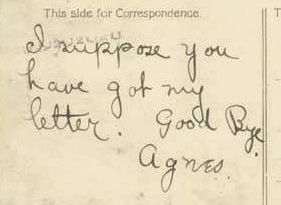 “I suppose you have got my letter. Good Bye. Agnes.” That is all that Agnes had to say to Mr. G. Greanbeam. Agnes sent that short message on the back of a postcard in the early 1900’s. I get the impression that Agnes is leaving a lot unsaid. This is just one of many postcards in Nebraska Memories that intrigue me.
“I suppose you have got my letter. Good Bye. Agnes.” That is all that Agnes had to say to Mr. G. Greanbeam. Agnes sent that short message on the back of a postcard in the early 1900’s. I get the impression that Agnes is leaving a lot unsaid. This is just one of many postcards in Nebraska Memories that intrigue me.
In January of 2012 I wrote a blog post titled Don’t Forget the Back. It’s now two years later and I still like to take the time to read the back of the postcards in Nebraska Memories. I want to share with you some of my recent finds and issue you a challenge.
Reading the backs of these two postcards I’m assume two little girls wrote them. On the back of the postcard featuring the Bryan Hammer Bldg. in Omaha is a short note from Margaret to her grandma asking her how she is. On the other card showing the fountain in the Brandeis Stores Rhoda wrote a note to her Aunt Etta. Rhoda told her that “I am a big girl I love you very much your little girl Rhoda”.
This next postcard of the Methodist Hospital, Omaha, Neb. was never mailed so we have no idea when or who wrote this cleaver saying on the back: “‘Hospital’ Where people who are run down, wind up!”
In October of 1911 someone with the initials CAM wrote to Miss Suzie Mathis in Swanton Nebraska. (For those of you like me who have not visited Swanton it is located about 50 miles south and a bit west of Lincoln.) CAM wanted to let Suzie know that all is well and that Russell had been in the hospital. “He has Varicose Veins in his right leg. 3 Dr’s worked on him 2 1/2 hours & took out 12 ft. of veins. he seems to be doing well but is feeling very sore”. Do you really think she meant 12 feet? I can understand why Russell was a bit sore.
With this last postcard I’d like to issue a challenge to everyone. What private message is Robby sending to his Sweet Heart Miss Blanche Shanklin with all of these letters? Here is the text of the postcard:
Miss Blanche Shanklin
Menlo
IowaGillette wyo April 24-13
Dearest Sweet Heart Thurs noon
this is a beautifull day but looks a little cloudy in the west I dont feel very good today and awful lonesome G.B.Y.D.H.I.D.W.Y.W.A.M.H.&.S.YAAJWTMC I sure will be glad when I start back for Sunny Brook and I don’t think it will be long either I will write when I get to Billings IAYODEJH Robby Pal
What do you think all of those letters mean? Don’t forget that this postcard was written in 1913. Leave a comment with your best guess. Maybe if a number of folks contribute we can decode the message. I don’t want to influence your interpretation of the message so I’m going to wait until next week to leave my best guess in the comments.
Visit Nebraska Memories to search for or browse through many more historical images digitized from photographs, negatives, postcards, maps, lantern slides, books and other materials.
Nebraska Memories is a cooperative project to digitize Nebraska-related historical and cultural heritage materials and make them available to researchers of all ages via the Internet. Nebraska Memories is brought to you by the Nebraska Library Commission. If your institution is interested in participating in Nebraska Memories, see http://nlc.nebraska.gov/nebraskamemories/participation.aspx for more information, or contact Beth Goble, Historical Projects Librarian, or Devra Dragos, Technology & Access Services Director.
Posted in General, Information Resources, Nebraska Memories, Technology
1 Comment
High-Rises of the Plains
Ding, ding! Going up … Oh, not that kind of elevator? An “elevator” in the country is different from an “elevator” in the city. Almost every town in Nebraska had a grain elevator at one time–right next to the train tracks. The railroads brought the farmers to the plains, then the farmers grew crops and brought grain to the railroads to be shipped back. But it had to be stored somewhere while waiting for transportation.
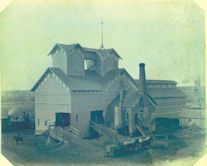
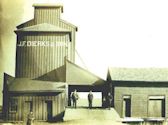 Elevators were originally built to store and move grain from docks into ships, but they worked just as well with trains. The mechanized “elevator” that moved the grain up and into silos sometimes used buckets and sometimes conveyor belts. Some towns had multiple elevators. The grain elevator pictured to the left was likely built by Seely, Son and Company of Fremont, Nebraska (Keene Memorial Library Collection). The picture to the right shows another elevator in Fremont, J.F. Dierks and Son.
Elevators were originally built to store and move grain from docks into ships, but they worked just as well with trains. The mechanized “elevator” that moved the grain up and into silos sometimes used buckets and sometimes conveyor belts. Some towns had multiple elevators. The grain elevator pictured to the left was likely built by Seely, Son and Company of Fremont, Nebraska (Keene Memorial Library Collection). The picture to the right shows another elevator in Fremont, J.F. Dierks and Son.
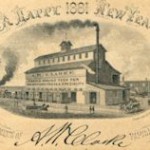
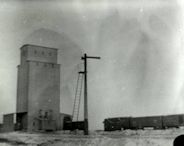 Elevator buildings might be plain or fancy, but they were originally all built of wood. The simple grain elevator to the left was outside of Omaha (Omaha Public Library Collection). Sometimes a company would combine its elevator with a mill to grind the grain before it was shipped. At the right is an illustration of such a company advertising its services with a New Year’s postcard from the A.W. Clarke Grain and Ground Feed in Papillion (Sarpy County Historical Museum Collection).
Elevator buildings might be plain or fancy, but they were originally all built of wood. The simple grain elevator to the left was outside of Omaha (Omaha Public Library Collection). Sometimes a company would combine its elevator with a mill to grind the grain before it was shipped. At the right is an illustration of such a company advertising its services with a New Year’s postcard from the A.W. Clarke Grain and Ground Feed in Papillion (Sarpy County Historical Museum Collection).
Additional images of grain elevators from towns around the state can be found in Nebraska Memories. Visit Nebraska Memories to search for or browse through many more historical images digitized from photographs, negatives, postcards, maps, lantern slides, books and other materials. You can also find pictures of buildings with the other kinds of elevators, too!
Nebraska Memories is a cooperative project to digitize Nebraska-related historical and cultural heritage materials and make them available to researchers of all ages via the Internet. Nebraska Memories is brought to you by the Nebraska Library Commission. If your institution is interested in participating in Nebraska Memories, see Nebraska Memories Participation for more information, or contact Beth Goble, Historical Services Librarian, or Devra Dragos, Technology & Access Services Director.
IMLS and Partners Present Financial Education and Citizenship Webinars
Two new federal partnerships will enhance the work of public libraries as providers of e-government services. Institute of Museum and Library Services (IMLS) partnerships with the Consumer Financial Protection Bureau (CFPB) and with the U.S. Citizenship and Immigration Services (USCIS) will result in new resources and tools for public libraries, including two webinars scheduled for December.
Nebraska public libraries are invited to participate in both of these free webinars: CFPB Webinar: Wednesday, December 4, 2:00 p.m. — 4:00 p.m. CT. Click here for more information. USCIS Webinar: Thursday, December 12, 11:30 p.m.—1:00 p.m. CT. Click here for more information. Please join us for these informative sessions and stay tuned for new developments from IMLS and its federal partners. – See more at: http://blog.imls.gov/?p=4396#sthash.qDaLQ9od.dpuf
Data Doodles: Rural Nature of Nebraska Public Libraries
Of the 93 counties in Nebraska, 80 have been designated as non-metropolitan.1
Within these rural counties there are 225 public libraries, or about 84% of the state’s 268 libraries. Among these rural libraries, 88% provide services to cities or villages with fewer than 5,000 residents. And within this group, 57% of the total number of Nebraska libraries serves a legal service area population of fewer than 1,000 residents.
The following table, based on locale categories devised by the U.S. Department of Education, provides a broad picture of how the majority of Nebraska’s public libraries serve small, rural communities.
|
Urban-centric |
Nebraska |
||
|
City |
Large: |
2 |
|
|
Midsize: |
0 |
||
|
Small: Territory inside an urbanized area and inside a principal city |
0 |
||
|
|
|
|
|
|
Suburb |
Large: |
5 |
|
|
Midsize: |
2 |
||
|
Small: Territory outside a principal city and inside an urbanized area |
0 |
||
|
|
|
|
|
|
Town |
Fringe: |
2 |
|
|
Distant: |
9 |
||
|
Remote: Territory inside an urban cluster that is more than 35 miles |
30 |
||
|
|
|
|
|
|
Rural |
Fringe: |
3 |
|
|
Distant: |
46 |
||
|
Remote: Census-defined rural territory that is more than 25 miles from |
169 |
||
|
Total |
268 |
||
|
Source: U.S. Department of Education, National Center for Education Statistics (NCES), Common Core of Data (CCD), Identification of Locale Codes, from http://nces.ed.gov/ccd/rural_locales.asp. |
|||
1 According to the “core-based statistical area” system used by the U.S. Office of Management and Budget.
Posted in General, Information Resources
Leave a comment
Window Shopping in Nebraska Memories
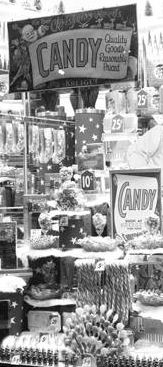 With the holiday season just around the corner I thought it would be the perfect time to do a bit of window shopping in Nebraska Memories. While I’m not sure all of the items on display would be the best option for gift giving it is still fun to look.
With the holiday season just around the corner I thought it would be the perfect time to do a bit of window shopping in Nebraska Memories. While I’m not sure all of the items on display would be the best option for gift giving it is still fun to look.
Let’s start our window shopping in Omaha at the S.S. Kresge Store. While I don’t know for sure I believe these two photos of window displays were taken at the Kresge store in downtown Omaha at the corner of 16th and Harney. 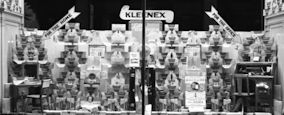 The Window display of candy includes candy canes, lollypops, and boxes of candy. The other photo taken at the Kresge Store is of a Kleenex window display. This photo from 1938 shows that Kleenex are good for both the home and the office.
The Window display of candy includes candy canes, lollypops, and boxes of candy. The other photo taken at the Kresge Store is of a Kleenex window display. This photo from 1938 shows that Kleenex are good for both the home and the office.
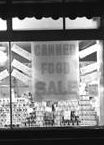 It looks like in 1937 grocery stores liked to display their canned goods by stacking them in the form of pyramids. This can be seen in two photos of grocery stores in Omaha. In the picture of the Saratoga Grocery and Meat Co. they are advertising a canned food sale in the window and have many can pyramids on display.
It looks like in 1937 grocery stores liked to display their canned goods by stacking them in the form of pyramids. This can be seen in two photos of grocery stores in Omaha. In the picture of the Saratoga Grocery and Meat Co. they are advertising a canned food sale in the window and have many can pyramids on display. 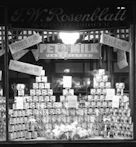 The I.W. Rosenblatt Food Store also has an impressive display of canned items on display in their window. Their mammoth canned food sale includes peas, corn, apricots, kraut and Pet milk.
The I.W. Rosenblatt Food Store also has an impressive display of canned items on display in their window. Their mammoth canned food sale includes peas, corn, apricots, kraut and Pet milk.
Today the thought of having a one cent sale seems unlikely but in 1931  the Harley Drug located at 1101 O Street in Lincoln had a huge once cent sale. The window display shows numerous items along with two large signs shaped as the number one that appear to list a number of items for sale.
the Harley Drug located at 1101 O Street in Lincoln had a huge once cent sale. The window display shows numerous items along with two large signs shaped as the number one that appear to list a number of items for sale.
The last window on my window shopping trip is that of the Capitol Hardware that was located at 1447 O Street, Lincoln in 1946. Their window is full of Sunbeam electrical appliances. The display includes waffle baker, toaster, Mixmaster, iron (for $9.95), razor (for $15.90). A sign also states that “the Sunbeam Man” will be in the store all day Saturday!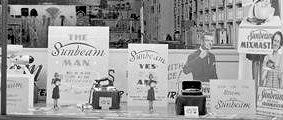
I hope you enjoyed our window shopping trip in Nebraska Memories. We didn’t see all of the window displays today so there are more to see in Nebraska Memories.
Visit Nebraska Memories to search for or browse through many more historical images digitized from photographs, negatives, postcards, maps, lantern slides, books and other materials.
Nebraska Memories is a cooperative project to digitize Nebraska-related historical and cultural heritage materials and make them available to researchers of all ages via the Internet. Nebraska Memories is brought to you by the Nebraska Library Commission. If your institution is interested in participating in Nebraska Memories, see http://nlc.nebraska.gov/nebraskamemories/participation.aspx for more information, or contact Beth Goble, Historical Projects Librarian, or Devra Dragos, Technology & Access Services Director.
Fall Database Trials Available
The Nebraska Library Commission is currently hosting free trials of the following databases, which may be of interest to your library:
- EBSCO eBook High School Collection
- EBSCO eBook Subscription K-8 Collection
- EBSCO eBook Public Library Collection
- EBSCO eBook Academic Collection
- EBSCO eBook Commuity College Collection
- Mango Languages
- McGraw-Hill AccessScience
- McGraw-Hill AccessEngineering
- McGraw-Hill E-Book Library
- Pronunciator
To receive future announcements about trials, including access instructions, make sure you are subscribed to the TRIAL mailing list. You can also always find currently available trials listed on our Database Trials page.
If you aren’t currently a member of the TRIAL mailing list and therefore didn’t receive trial access instructions, or if you’d like to have them sent to you again, please email Susan Knisely.
Posted in Information Resources, Technology
Leave a comment
Oh for a Book and a Quiet Nook
The Joy of Reading – John Wilson
Oh for a book and a shady nook, either in door or out.
With the green leaves whispering overhead,
Or the street cries all about.
Where I may read all at my ease,
Both of the new and old;
For a jolly good book whereon to look,
Is better to me than gold.
This month seems to be all about books! October is National Reading Group Month. Teen Read Week is October 13-19. On October 26th the Celebration of Nebraska Books will feature 2013 award-winning authors and their books, and announcement of the 2014 One Book One Nebraska title. With all that to celebrate it seems like a good time to see what images about books and reading are in Nebraska Memories.
The two photos below are from the Dodge County Historical Society collection. The photo of the Joseph H. Williams residence reading corner , taken in about 1888, shows an unusual bookcase with a rocking chair beside it. The girls posed in front of it don’t look very happy with the book in front of them. Hopefully there was something entertaining on the shelves above them! The family members posing in the Robert S. Somers residence reading group photo look pretty serious too.
The siblings in this story gathering photo from the Nebraska Children’s Home Society look like they are having more fun. Photos of children up for adoption were used to help the Society find adoptive parents.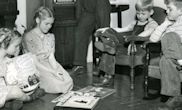 The Library Commission started bookmobile service in 1936, and a search in Nebraska Memories on the word bookmobile will bring up several photos of groups gathered around the wonderful truck with the side window showing the books. These women are at the Bookmobile at Nehawka Public Library .
The Library Commission started bookmobile service in 1936, and a search in Nebraska Memories on the word bookmobile will bring up several photos of groups gathered around the wonderful truck with the side window showing the books. These women are at the Bookmobile at Nehawka Public Library . 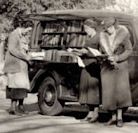
The Nebraska Bookmobile Report of the first Nebraska bookmobile is also available in Nebraska Memories. Enjoy reading this October!
Visit Nebraska Memories to search for or browse through many more historical images digitized from photographs, negatives, postcards, maps, lantern slides, books and other materials.
Nebraska Memories is a cooperative project to digitize Nebraska-related historical and cultural heritage materials and make them available to researchers of all ages via the Internet. Nebraska Memories is brought to you by the Nebraska Library Commission. If your institution is interested in participating in Nebraska Memories, see http://nlc.nebraska.gov/nebraskamemories/participation.aspx for more information, or contact Beth Goble, Historical Projects Librarian, or Devra Dragos, Technology & Access Services Director.
Honoring Grandparents
Every September, National Grandparents Day is celebrated on the Sunday after Labor Day. This holiday was created by Marian Lucille Herndon McQuade of West Virginia. In 1978, President Jimmy Carter declared it a national holiday. According to the National Grandparents Day website, the purpose of the day is “to honor grandparents, to give grandparents an opportunity to show love for their children’s children, and to help children become aware of the strength, information and guidance older people can offer.”
 Nebraska Memories contains several images of children and their grandparents. The Boston Studio collection includes posed portraits of grandparents and grandchildren together. More informal examples of grandparents spending time with their grandkids can be found in this 1924 photograph of Fred Zeeck and his granddaughter Betty and in this image of a Sioux grandmother
Nebraska Memories contains several images of children and their grandparents. The Boston Studio collection includes posed portraits of grandparents and grandchildren together. More informal examples of grandparents spending time with their grandkids can be found in this 1924 photograph of Fred Zeeck and his granddaughter Betty and in this image of a Sioux grandmother
and granddaughter sitting together near a fire. This stereoscopic photograph titled “A Letter to Grandma” shows a young girl sitting at a desk, writing a letter to her grandmother.
 Visit Nebraska Memories to search for or browse through many more historical images digitized from photographs, negatives, postcards, maps, lantern slides, books and other materials.
Visit Nebraska Memories to search for or browse through many more historical images digitized from photographs, negatives, postcards, maps, lantern slides, books and other materials.
Nebraska Memories is a cooperative project to digitize Nebraska-related historical and cultural heritage materials and make them available to researchers of all ages via the Internet. Nebraska Memories is brought to you by the Nebraska Library Commission. If your institution is interested in participating in Nebraska Memories, see http://nlc.nebraska.gov/nebraskamemories/participation.aspx for more information, or contact Beth Goble, Historical Services Librarian, or Devra Dragos, Technology & Access Services Director.
Posted in Information Resources, Nebraska Memories, Technology
2 Comments
NCompass Live: Affordable Care Act Resources for Libraries

Join us for the next NCompass Live: “Affordable Care Act Resources for Libraries”, on Wednesday, September 4, 10:00-11:00 am Central Time.
Health Care Insurance Open Enrollment, the next phase of the Affordable Care Act, is fast approaching: October 1st! In this segment about the Affordable Care Act, Mary Sauers, Government Information Services Librarian at the Nebraska Library Commission, will provide updates to new ACA information websites, organizations, and materials to help you, your library, and your patrons continue to prepare for this event.
Upcoming NCompass Live events:
- Sept. 11 – Scholarship Student Reflections on ALA 2013
- Sept. 18 – Tech Talk with Michael Sauers
- Sept. 25 – Genealogy Resources for Librarians
For more information, to register for NCompass Live, or to listen to recordings of past events, go to the NCompass Live webpage.
NCompass Live is broadcast live every Wednesday from 10am – 11am Central Time. Convert to your time zone on the Official U.S. Time website. The show is presented online using the GoToWebinar online meeting service. Before you attend a session, please see the NLC Online Sessions webpage for detailed information about GoToWebinar, including system requirements, firewall permissions, and equipment requirements for computer speakers and microphones.
Back to College
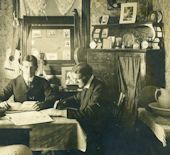 It’s that time of year again when students are preparing to head back to college. Looking at the photos of two Union College dorm rooms from the early 1900’s I’m guessing it took those students a lot less time to move into their dorm rooms then it does for students today. This 1907 picture of a Union College dorm room shows two men dressed in suits and ties sitting at a table studying. The room is simply furnished with a bed, table, nigh stand and wardrobe. The wardrobe is covered with knickknacks and photos. A guitar,
It’s that time of year again when students are preparing to head back to college. Looking at the photos of two Union College dorm rooms from the early 1900’s I’m guessing it took those students a lot less time to move into their dorm rooms then it does for students today. This 1907 picture of a Union College dorm room shows two men dressed in suits and ties sitting at a table studying. The room is simply furnished with a bed, table, nigh stand and wardrobe. The wardrobe is covered with knickknacks and photos. A guitar, lute mandolin and banjo are sitting next to the window. 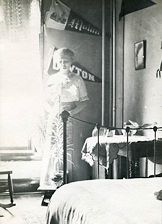 The women’s dorm room in this picture from 1911 or 1912 is also simply furnished with a bed, table and rocking chair. The walls are decorated with variety of pennants. The young woman in the photo is wearing a dress and is standing behind a potted plant.
The women’s dorm room in this picture from 1911 or 1912 is also simply furnished with a bed, table and rocking chair. The walls are decorated with variety of pennants. The young woman in the photo is wearing a dress and is standing behind a potted plant.
I find it interesting to look at the different styles of buildings that were used as dormitories and how they differ from campus to campus and have changed over the years. The photo of Green Terrace Hall is the oldest photo of a dormitory included in Nebraska Memories. Green Terrace Hall was a women’s dormitory at Nebraska State Normal School at Kearney.  The picture is dated July 10, 1903 and shows a large building that contained 74 rooms, 16 halls, 40 closets, 6 bathrooms, 4 toilet rooms with basins, 8 water closets and 4 kitchen sinks. According to the note included in the record this dorm earned the nickname of “Cockroach Castle” sometime before it was demolished in 1959-1960.
The picture is dated July 10, 1903 and shows a large building that contained 74 rooms, 16 halls, 40 closets, 6 bathrooms, 4 toilet rooms with basins, 8 water closets and 4 kitchen sinks. According to the note included in the record this dorm earned the nickname of “Cockroach Castle” sometime before it was demolished in 1959-1960.
 East Hall and South Hall were located on the campus of Union College in 1911-1912. I think both of these dorms had a bit more of a homey look to them because of the large covered front porches on both structures. Like the Green Terrace Hall the East Hall also received a couple of nicknames over the years.
East Hall and South Hall were located on the campus of Union College in 1911-1912. I think both of these dorms had a bit more of a homey look to them because of the large covered front porches on both structures. Like the Green Terrace Hall the East Hall also received a couple of nicknames over the years. The students living in the dorm called it the “White House” while other students referred to it as the “Cracker Box.”
The students living in the dorm called it the “White House” while other students referred to it as the “Cracker Box.”
The first high-rise residences hall that was built on Wayne State College’s campus was built in 1965. In this picture you can see Bowen Hall during the construction process. According to Wayne State College’s website Bowen Hall is still being used today as a residence hall. The most recent photo of a dormitory that can be found in Nebraska Memories is that of Centennial Hall. Centennial Hall is located on campus of Nebraska Wesleyan University. The photo was taken sometime between 1967 and 1971. According the Nebraska Wesleyan’s website Bowen Hall is also still being used today.
Visit Nebraska Memories to search for or browse through many more historical images digitized from photographs, negatives, postcards, maps, lantern slides, books and other materials.
Nebraska Memories is a cooperative project to digitize Nebraska-related historical and cultural heritage materials and make them available to researchers of all ages via the Internet. Nebraska Memories is brought to you by the Nebraska Library Commission. If your institution is interested in participating in Nebraska Memories, see http://nlc.nebraska.gov/nebraskamemories/participation.aspx for more information, or contact Beth Goble, Historical Projects Librarian, or Devra Dragos, Technology & Access Services Director.
Posted in General, Information Resources, Nebraska Memories, Technology
2 Comments
I Scream, You Scream
We all scream for ice cream! On these hot summer days, spend some time cooling off by looking at images that relate to ice cream in Nebraska Memories.
 One of the oldest images of people eating ice cream is this photograph from the Nebraska State Historical Society collection. Members of the Nelson family are gathered around a table in front of a house, enjoying ice cream with their cake.
One of the oldest images of people eating ice cream is this photograph from the Nebraska State Historical Society collection. Members of the Nelson family are gathered around a table in front of a house, enjoying ice cream with their cake.
While the image of the Nelson family is the only image of a family enjoying ice cream at home in Nebraska Memories, there are several images of commercial ice cream shops. This 1915 photograph shows the soda fountain at Herpolsheimer’s department store. Several employees in crisp white uniforms stand behind the counter, waiting to serve ice cream and sodas to customers. A later image shows the exterior of Reeds Ice Cream Shop in Omaha, advertising the day’s special of chocolate malted milk. Another image shows the City Café in David City. Although the teenagers in this photograph are enjoying sodas and not ice cream, you can see ice cream and syrup dispensers on the counter behind the young employee, who is wearing a bowl on his head and grinning for the camera.
waiting to serve ice cream and sodas to customers. A later image shows the exterior of Reeds Ice Cream Shop in Omaha, advertising the day’s special of chocolate malted milk. Another image shows the City Café in David City. Although the teenagers in this photograph are enjoying sodas and not ice cream, you can see ice cream and syrup dispensers on the counter behind the young employee, who is wearing a bowl on his head and grinning for the camera.
 To explore the opposite end of the ice cream industry, take a look at this photograph of the Arctic Cream Company in Fremont. According to the advertising on the side of the building, this company produced butter and ice cream.
To explore the opposite end of the ice cream industry, take a look at this photograph of the Arctic Cream Company in Fremont. According to the advertising on the side of the building, this company produced butter and ice cream.
Visit Nebraska Memories to search for or browse through many more historical images digitized from photographs, negatives, postcards, maps, lantern slides, books and other materials.
Nebraska Memories is a cooperative project to digitize Nebraska-related historical and cultural heritage materials and make them available to researchers of all ages via the Internet. Nebraska Memories is brought to you by the Nebraska Library Commission. If your institution is interested in participating in Nebraska Memories, see http://nlc.nebraska.gov/nebraskamemories/participation.aspx for more information, or contact Beth Goble, Historical Services Librarian, or Devra Dragos, Technology & Access Services Director.
Nebraska – 125 Years Ago
Recently I was browsing the Nebraska Memories website and ran across a photo of Omaha taken from the intersection of Center Street near 40th Street. The date of the photo was 1888. I did a bit of searching in Nebraska Memories and was pleasantly surprised with the variety of items all from 1888. Here are a few items that made an impression on me.
 Let’s start in the panhandle with a picture of Crawford. The picture appears to be showing main street or business area of town. Reading the note included with the picture I learned that sometime in the future most of the wooden buildings on the right side of the photo were destroyed in a fire. It’s hard to imagine how devastating of a loss that would be for the town.
Let’s start in the panhandle with a picture of Crawford. The picture appears to be showing main street or business area of town. Reading the note included with the picture I learned that sometime in the future most of the wooden buildings on the right side of the photo were destroyed in a fire. It’s hard to imagine how devastating of a loss that would be for the town.
Unfortunately the next stop in Fillmore County also isn’t very cheerful. On January 12, 1888 a bad blizzard hit the Great Plains. There are no pictures of the blizzard but there is a book in Nebraska Memories documenting the 50th anniversary of the blizzard. You can learn more about the blizzard and this book in Blizzard Reunion blog post.
 Let’s move on to a happier occasion and look at the program from the Lincoln May Music Festival that was held at the First Congregational Church in Lincoln on May 14-16, 1888. At first this may not sound that interesting unless you are a music lover but I was surprised with all of the interesting things I learned looking at the program. As you expect there is great information about the concerts and performers but you will also ads from local businesses. Looking at the program I learned:
Let’s move on to a happier occasion and look at the program from the Lincoln May Music Festival that was held at the First Congregational Church in Lincoln on May 14-16, 1888. At first this may not sound that interesting unless you are a music lover but I was surprised with all of the interesting things I learned looking at the program. As you expect there is great information about the concerts and performers but you will also ads from local businesses. Looking at the program I learned:
- It would have cost your 50 cents to attend the festival or you could have purchased season tickets for $1.25.
- At the festival they performed Judas Maccabaeus composed by George Frederic Handel and The Holy City by A. R. Gaul.
- J. E. Miller advertised “Best Quality Body Brussels Carpet” for $1.05 per yard. The ad didn’t mention installation.
- A single meal at the Odell’s Dinning Hall would cost you 25 cents or you could pay $4.50 per week.
- The ad for “Leavitt’s Domestic” does not say what they are selling. Based on the picture and wording I’m guessing its coal. Whatever it is will cost you $7.65 delivered and it “Burns to Clean Ash. – Makes no Soot nor Clinker.”
- Folks saving their money at the Union Savings Bank they would receive interest. “Paid depositors at the rate of Five per cent per annum on all deposits exceeding $5.00 and under $3,000.00, for all full calendar months such deposit is in bank. Interest payable semi-annually.”
 Let me end this tour of with the some photos of Omaha taken in 1888 by William Wallace. I’ve included links to the 1888 photos along with links to Google Street views of approximately the same location.
Let me end this tour of with the some photos of Omaha taken in 1888 by William Wallace. I’ve included links to the 1888 photos along with links to Google Street views of approximately the same location.
- Woolworth Avenue, looking east from Georgia Avenue
(Georgia Avenue is now 29th Street)
Google Street View - Corner of Georgia Avenue and Woolworth Avenue, looking northeast
Google Street View - Street grading on Center Street near 40th Street
If you haven’t heard of the street grading projects make sure you check out Emily’s blog post on Re-Shaping Omaha.
Google Street View
Visit Nebraska Memories to search for or browse through many more historical images digitized from photographs, negatives, postcards, maps, lantern slides, books and other materials.
Nebraska Memories is a cooperative project to digitize Nebraska-related historical and cultural heritage materials and make them available to researchers of all ages via the Internet. Nebraska Memories is brought to you by the Nebraska Library Commission. If your institution is interested in participating in Nebraska Memories, see http://nlc.nebraska.gov/nebraskamemories/participation.aspx for more information, or contact Beth Goble, Historical Projects Librarian, or Devra Dragos, Technology & Access Services Director.


